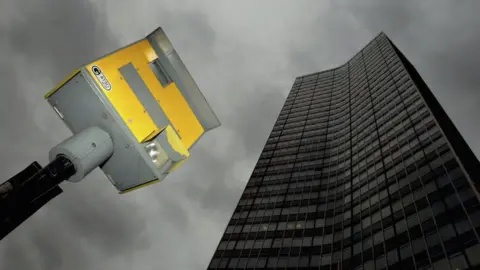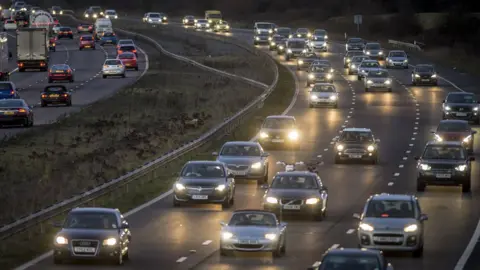Half of UK road speed cameras are switched off
 Getty Images
Getty ImagesOnly around half of fixed speed cameras on British roads are switched on, according to new data.
Figures released by 36 police forces in the UK show that of a total 2,838 cameras, just 1,486 - or 52% - are active and catching law-breakers.
Some forces have turned all their cameras off, according to information obtained by the Press Association (PA).
Northamptonshire police said its were shut off in 2011, but they left the structures in place to deter speeding.
PA sent a freedom of information to all 45 police forces in the UK and their speed camera partnership, of which 36 responded with details of their fixed speed cameras. It did not include data on the mobile devices forces use to catch offenders.
Staffordshire police said it has 272 cameras across its region but that only 14 are active. While Derbyshire said just 10 of its 112 cameras were active.
In common with Northamptonshire, Cleveland, Durham and North Yorkshire said that none of their fixed cameras were switched on.
A spokeswoman for the National Police Chiefs' Council said the decision to use cameras was "an operational matter", adding that "all forces have individual responsibility for their use of speed cameras".

- Fixed speed cameras in Cleveland, Durham, North Yorkshire and Northamptonshire are all inactive
- Staffordshire Police has 272 fixed cameras across the region, of which 14 are active
- In Scotland, less than 29% of fixed cameras are switched on
- Forces where less than 25% of fixed cameras are active: West Yorkshire, Kent, South Yorkshire, Greater Manchester and Cheshire
- Derbyshire force operates 112 cameras, of which 10 are switched on
- Gwent police force has 17 fixed speed cameras of which 8 are active while South Wales has 88, 59% of which are switched on
- Police forces with all fixed speed cameras switched on include: the City of London, the Metropolitan Police/Transport for London, Lancashire, Nottinghamshire, Suffolk and Northern Ireland

Edmund King, president of the AA, said: "Many of the empty yellow cases are due to cuts in road safety grants and the fact that digital cameras, although more effective, are very expensive."
He added: "It has long been the case that cameras were moved between sites, depending on need. When it comes to the chances of being caught on camera, it is a postcode lottery. All cameras in City of London and Suffolk are working whereas only 5% are active in Staffordshire."
"However, drivers should remember that lack of a yellow fixed camera doesn't mean they are immune from mobile hidden cameras. Best advice is stick to the limits rather than gambling on the yellow boxes."
 PA
PAClaire Armstrong, co-founder of the lobby group Safe Speed, which campaigns for more traffic police officers, said that fixed speed cameras "are nothing to do with road safety".
She claimed that "average cameras have a 5% negative effect on road safety, Gatso [yellow box cameras] have a 13% negative effect and a policeman on the side of the road will have a 27% benefit, so why are we using policies that are not effective and that we know have a negative effect on road safety?".
However, Neil Greig, director of policy and research for the charity IAM Road Smart, said: "There's clear evidence at locations where cameras are located, they are there for road safety reasons.
"They don't just appear out of nowhere. They have to go through a process involving looking at the road accident record at that location.
"Each of these locations is a site that has got some kind of accident problem and that's why we want to be sure that there's protection there all the time for the people who live around those sites."
